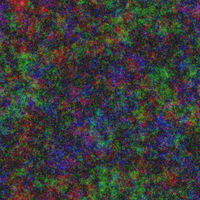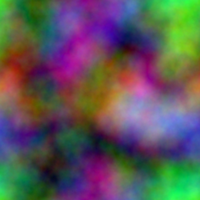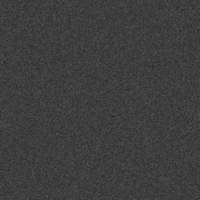Noise (physics)
In physics, noise (also known as background ) generally means a disturbance with a broad, unspecific frequency spectrum . It can therefore be interpreted as a superposition of many harmonic oscillations or waves with different amplitudes and frequencies or wavelengths .
When transmitting communication signals, noise is usually the greatest source of interference. The noise sources occur in the entire transmission system, i.e. in the transmitter, in the receiver and on the transmission path. A distinction is made between the noise power generated by external and internal noise sources. In communications technology , the quality of the signals is specified using the so-called signal-to-noise ratio ( signal-to- noise ratio).
Particularly in analog audio technology, radio and radio-based communication technology , during the development history of these technologies in the 20th century, great efforts were made to develop efficient noise suppression methods. Due to the triumph of digital technology - largely noise-free due to the principle involved - in communication technology and entertainment electronics , such processes have almost completely lost their importance in devices with the latest technology.
Research history and physical causes
Noise was first described as a physical phenomenon, namely as measurable irregular current fluctuations, by Walter Schottky in 1918 ( Annalen der Physik 57 (1918), 541). If these current fluctuations are audible after amplification via a loudspeaker, a typical noise is heard that gave the phenomenon its name. In the meantime, the term “noise” is used in a much more general way, as defined above.
The pioneers of experimental and theoretical investigation of physical noise processes include among others John Bertrand Johnson (1887-1970), ten years after Schottkys discovery the thermal noise verified experimentally, and after the Anglo-Saxon literature the thermal noise as Johnson noise is named , and Harry Nyquist , who also developed a model of the power spectral density of thermal noise ten years after Schottky's first publication .
Another important physical cause of noise is also described in Schottky's 1918 publication, shot noise . In 1925, J. B. Johnson found the flicker during a review of Schottky's publication .
A variety of other physical noise phenomena have since been discovered. The generation recombination noise in semiconductors and the cosmic background noise are representative here . The latter is received by radio astronomical receiving devices from those directions where there are no known cosmic objects. So it is everywhere and it comes from all directions. According to today's models, this noise is a holdover from the cosmic big bang . From the radio astronomer's point of view, noise can not only act as a disturbance variable (such as the noise generated by the receiving system itself), but also e.g. B. be a useful variable as background radiation.
In the case of the noise thermometer , noise is also evaluated as a useful variable.
Many physical noise phenomena are still the subject of intensive research today.
The causes of twinkling or 1 / f noise cannot be explained classically. In terms of quantum theory , a uniform representation is possible.
Shot noise or Poisson shot noise arises from the fact that individual charge carriers, whose energy is statistically distributed, cross a potential barrier.
Spectral power density
In addition to physical causes, noise is also classified according to the parameters of the stochastic processes or according to measurable quantities that describe the noise. The latter includes, for example, the spectral power density, which is the power per (infinitesimally smaller) bandwidth. It generally depends on the frequency .
The spectral power density in the broader sense or the mathematical spectral power density is obtained as a Fourier transform of the autocorrelation function of a stationary random process. (Example: autocorrelation function of the noise voltage across an ohmic resistor ).
The spectral power density in the narrower sense or the physical spectral power density is obtained as a Fourier transform of the cross-correlation function of two random processes. The cross-correlation function for argument 0 must be a physically sensible performance. (Example: cross-correlation function from noise current through and noise voltage across an ohmic resistor).
Noise processes with constant spectral noise power density in the broader sense are called white noise in analogy to white light, which includes all spectra (frequencies) of visible light with the same power (intensity). In reality, noise processes with constant spectral noise power density cannot exist because they would have to transport an infinitely large amount of power. However, there are physical noise processes whose spectral noise power density is practically constant in a certain more or less large frequency band, even in the narrower sense. For the sake of simplicity, these processes are then also referred to as white . These include, for example, thermal noise and shot stream noise. This quasi-white noise often arises from the fact that only a section of Gaussian noise , i.e. noise in which the amplitudes of the individual frequencies is Gaussian , is considered or is relevant in which the amplitudes can be regarded as practically constant . White noise is not self-similar .
A noise process with a spectral power density that deviates significantly from a constant value in a frequency range that is relevant in practice is called "colored noise". In contrast to “white noise”, however, there is no generally accepted definition for different types of colored noise power spectra. For example, the term “pink noise” can be found both for noise with a spectral noise power density that decreases in inverse proportion to the frequency and for noise processes with a spectral noise power density that decreases in inverse proportion to the square of the frequency.
In order to avoid this ambiguity, the term " 1 / f noise " is used in scientific publications for processes whose spectral noise power density is inversely proportional to the frequency . Sometimes the 1 / f² noise is referred to as "red noise" to distinguish it from "pink noise", since the amplitudes in the low-frequency range (with red light) are higher. In a light spectrum, this would correspond to a shift in color into red. Some sources also speak of "brown noise" in this context.
Sources of noise
External noise sources:
- Background noise (also heat noise ) due to the formation of space
- Cosmic noise - mainly from the fixed stars of the Milky Way system (decreases by about 1 / f³)
- Terrestrial noise such as atmospheric heat noise , lightning discharges , ignition sparks , brush fire on electrical machines and switching operations
- Contact noise at contact points between electrical conductors and / or semiconductors
Internal noise sources:
- Heat noise (also called thermal noise , resistance noise or Johnson noise , called Nyquist noise ) in conductors
-
Tube noise in electron tubes
This is where shot noise (also shot effect or emission noise ), current distribution noise , influenza noise , ionization noise , secondary emission noise , insulation noise and flicker noise play a role. - 1 / f² noise in Brownian motion
- Barkhausen noise (see also Barkhausen effect ) by turning over the Weiss domains in ferromagnetics
- Generational recombination noise in semiconductors
- Chrominance noise (also color noise ) and luminance noise (also brightness noise ) in digital images
Manifestations
Overview table
| Heat noise |
1 / f noise
pink noise |
1 / f² noise
red noise |
|
|---|---|---|---|
| One-dimensional noise signals |

|

|

|
|
Two-dimensional, colored noise signals |

|

|

|
|
Two-dimensional, gray-scale noise signals |

|

|

|
| Audio samples, mono |
Image noise
The image noise in an analog video and television is, a random pixel pattern which is displayed when a television or -empfängers no signal is received from the antenna. The pattern looks like randomly flickering dots or "snow". It arises from the fact that the antenna picks up electromagnetic oscillations or an electromagnetic background noise . Most of the time you see this effect on analog TVs without a set channel or on empty VHS tapes.
There are many sources of electromagnetic oscillations that generate the characteristic “snow” image. They can come from the atmosphere, from nearby transmitting antennas, or from cosmic microwave background radiation .
Noise can occur even if there are no signal sources in the vicinity, because the television set itself is also a source of noise. So the built-in components can also generate noise. Most of the noise comes from the first transistor just behind the antenna connector.
Due to the algorithms used for digital television reception, the image noise is less random.
English TV viewers used to see image noise in the form of black instead of white dots. The reason for this was the modulation technique used. English broadcasters used positive video modulation while other countries (and now England) used negative modulation.
Most modern televisions no longer display picture noise, but instead display a colored area with a message such as “No signal” or something similar.
Radio and sound technology
The term signal-to-noise ratio (SNR) is used in high-frequency , measurement and communications technology as well as acoustics . The SNR initially served as a rating number for assessing the quality of an analog communication path. In order to be able to extract the information reliably from the signal, the useful signal must stand out clearly from the background noise, so the SNR must be sufficiently large. This plays a major role in sound recordings , for example . If the SNR falls, the bit error rate can rise in digital transmissions of sound or video . In earlier analog television , an input signal that was too low at the antenna input, for example due to twisting of the house antenna (mostly Yagi-Uda antennas ) or too great a distance to a television transmission tower , resulted in a noisy picture due to the insufficient SNR.
See also
literature
- JB Johnson: The Schottky Effect In Low Frequency Circuits. In: Phys. Rev. Volume 26, 1925, pp. 71-85, doi: 10.1103 / PhysRev.26.71
- JB Johnson: Thermal Agitation of Electricity in Conductors. In: Phys. Rev. Volume 32, 1928, pp. 97-109, doi: 10.1103 / PhysRev.32.97
- H. Nyquist: Thermal Agitation of Electric Charge in Conductors. In: Phys. Rev. Volume 32, 1928, pp. 110-113, doi: 10.1103 / PhysRev.32.110
- E. Pehl: Digital and analog message transmission. Hüthig, Heidelberg 2001, ISBN 3-7785-2801-7 .
- W. Schottky: About spontaneous current fluctuations in different electricity conductors. In: Annalen der Physik 362, 1918, pp. 541-567, doi: 10.1002 / andp.19183622304
- W. Schottky: Small-Shot Effect and Flicker Effect. In: Phys. Rev. Volume 28, 1926, pp. 74-103, doi: 10.1103 / PhysRev.28.74
Web links
- What is noise (PDF; 1.2 MB)
- Calculation of the noise voltage in microvolts and the noise level in dBu and dBV for Johnson or Nyquist noise
Individual evidence
- ↑ a b Antenna basics ( memento from January 25, 2013 in the web archive archive.today ) on HDTV Primer.
- ^ Background on the Background Explorer and the Science of John Mather. NASA.
